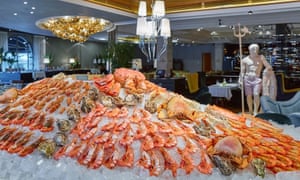 |
| Russian seafood at Erwin |
A ban on imported ingredients from the EU has led restaurants to source local produce – sparking fresh interest in Russian food
Not so long ago, the idea of naming an upmarket Moscow restaurant after an unfashionable provincial Russian town would have been met with confusion.
These days things are different. Voronezh, which opened a few months ago in a restored central Moscow mansion, is often booked out a week in advance. Its success, and that of dozens of other restaurants, reflects trends which have, in a short space of time, transformed Moscow from culinary wasteland into foodie paradise.
Russia’s sanctions on imported fruits, vegetables, meat and fish from the EU and a number of other countries – introduced in response to western sanctions over the annexation of Crimea and war in east Ukraine – prompted anger but also provided extra stimulus to a focus on locally sourced ingredients that was already under way, and created new interest in Russian ingredients.
On top of attempts at sanctions busting, which have involved imitating European cheeses and meats, with mixed results, there has also been a drive to rediscover Russian cuisine and use Russian ingredients. Voronezh uses only Russian meat, while across town at Erwin, diners can feast on Kamchatka crab, Murmansk scallops and dozens of unusual fish from Russia’s many seas and rivers.
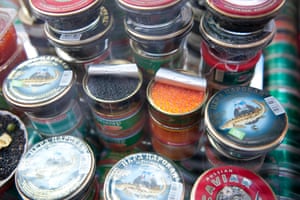
Thanks to the climate and decades of shortages, traditional Russian food can be a gruelling experience for the uninitiated, such as “salads” swimming in factory-made mayonnaise, and bland root vegetables. But at Zhivago, the focus is on doing the classics well, with mouth-watering pies with various fillings, many kinds of pelmeni dumplings, and seven types of caviar to dollop on to pancakes.
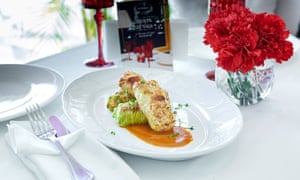
Russian food’s new fashionable status is one of the more benign consequences of the increased nationalism of the past two years. Even the doyen of the Moscow restaurant scene, Arkady Novikov, famous for opening dozens of upmarket restaurants in the capital over the past two decades, has gone local. His recent restaurants include Cheese Factory, where analogues to sanctioned cheeses are made on the premises, and Valenok, where Soviet cafe food is given an upmarket twist in glamorous surroundings. A valenok is a traditional Russian fur boot, and a model boot the size of a house announces the restaurant from the street.
Alongside the return to well-made comfort food, something new is also happening. In much the same way as British or Scandinavian restaurants discovered their own vernacular, a whole set of Moscow eateries featuring dishes that are both traditionally Russian and completely new has sprung up.
At Kutuzovsky 5, Russian recipes from two centuries ago are given a fresh twist with fine ingredients and cutting-edge cooking techniques. At Northerners, Murmansk scallops are served with carrot hummus and beetroot slices in a Russo-Nordic mashup. Almost every week a new restaurant opens with a “new Russian” theme in the kitchen.
Ivan and Sergey Berezutskiy, chefs who opened the restaurant Twins in central Moscow in late 2014, were pioneers in the focus on Russian ingredients.
“We had both worked in various Italian and French restaurants over the years and we thought it was weird that we know so much about Parma ham and other foreign products but nothing about our own interesting ingredients,” said Sergey.
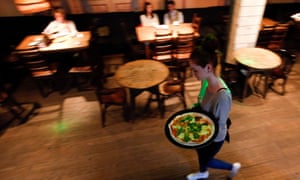
One item they are particularly proud of is cured goose from Bashkortostan. “We’ve found a granny who cures it for us specially. It’s impossible to buy it anywhere in Moscow, and previously nobody outside the region knew about it, but it’s as good as any jamon,” said Sergey. They serve flakes of the cured meat with pumpkin ravioli.
The sanctions have sparked a drive to improve local agriculture, but also played into a natural process of eating locally sourced products that was already getting under way.
“People have begun to realise that the most important thing is to eat fresh food,” said Sergey. “Even with the sanctions, there are plenty of other countries we can import fish from, but why should we when we live in a country with more seas, rivers and lakes than any other?”
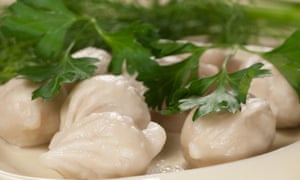
In a country that spans one-sixth of the world, “locally sourced” can be a relative term. Crabs from Magadan and Kamchatka have twice as far to travel to Moscow as fish from Europe, and internal Russian logistics are poor, which accounts for why so much good regional produce goes undiscovered. Restaurateurs say it is easier to bring ingredients to Moscow from Paris than it is from Murmansk.
Sanctions and the determination of Russian chefs are slowly changing that. In times of economic difficulty and a weak rouble, using local products also helps keep the bill down, and explains why so many Moscow restaurants are packed despite the troubled times. The transformation of restaurants from places for special occasions to everyday eating venues continues apace and is rearing a whole new generation of Muscovite foodies.
“Moscow is becoming one of the best places to eat in the world,” said local food critic and restaurant consultant Sasha Sutormina. “Two years ago you certainly couldn’t say that, but now when I have friends here from London, Hong Kong or Paris, they can’t believe how good it is.”
By Shaun Walker in Moscow
No comments:
Post a Comment